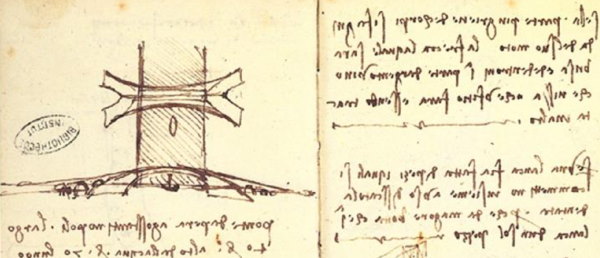After French troops invaded Milan in 1499, Leonardo da Vinci fled Milan and eventually settled in Venice, where he came into contact with Ottoman Turkish merchants.
The merchants informed him that Ottoman Sultan Bayezid II was looking for an engineer who could construct a bridge over Halic, (the Golden Horn).
On their advice, Da Vinci sent a letter to the Ottoman monarch spelling out his designs. A copy of the correspondence was discovered in the Topkapi Palace archives in 1952. Ottoman officials, however, mistakenly attributed the note to a ‘Ricardo of Genoa.
In his own notes, he always wrote in Italian from right-to-left (in ‘mirror script’), and on this occasion, he actually wrote a letter in Turkish in the ‘Arabic Style’ from right-to-left.
Here is the letter from Leonardo da Vinci to the Ottoman Sultan;
“I, your faithful servant, understand that it has been your intention to erect a bridge from Galata (Pera) to Stambul… across the Golden Horn, but this has not been done because there were no experts available. I, your subject, have determined how to build the bridge. It will be a masonry bridge as high as a building, and even tall ships will sail under it,”.

But the da Vinci’s ambitions did not end there, as he also proposed to build a further bridge connecting Europe and Asia, across the Bosphorus Strait.
Here is the second part of the letter from Leonardo da Vinci to the Ottoman Sultan;
“I plan to build a suspension bridge across the Bosporus to allow people to travel between Europe and Asia. By the power of God, I hope you will believe my words. I will be at your beck and call at all times,” he adds, signing the letter “Architect/engineer Leonardo da Vinci.”
In ordinary long bridges from the period, semi-circular arches and piers were built along the length of the structure to maintain its structural integrity. However, Leonardo proposed a single arch spanning the waterway, which would have risen to 43 meters above sea level and would have been 240 meters long. The specifications would allow boats to pass under the bridge with ease.
These ideas were revolutionary, as no bridges existed along the Golden Horn and the Bosphorus. The first suspension bridges would have not been built until 400 years after the letter which would be in the 20th century.
However, despite his clear enthusiasm, the Ottomans did not hire the great artist and, for hundreds of years, the letter was lost. Why there was no response remains a mystery.
The sketch of a bridge appeared in one of Leonardo’s notebooks in a royal library in France in the early 20th century.